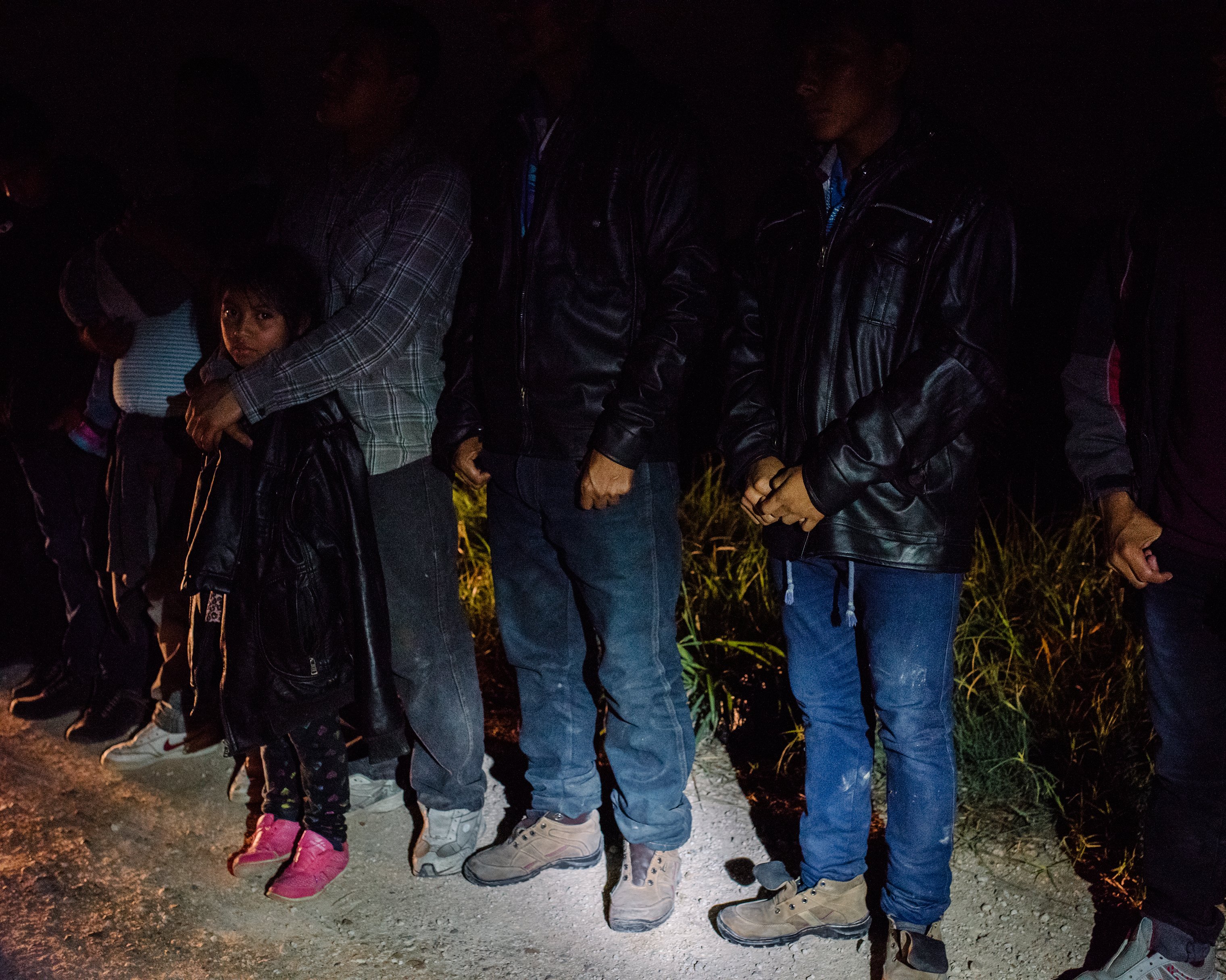It is still dark out when Border Patrol agent Herman Rivera’s radio crackles to life. His fellow agents, posted nearby on levee roads above the Rio Grande, report movement along the border with Mexico in the dim predawn. As the first rays of sunlight creep across the horizon, the team bursts into action, charging down into the scrub, dodging bushes and ducking under low-hanging branches in pursuit of migrants. Helicopter blades whomp overhead.
“I’ve got one over here,” an agent yells from a field where stalks of sugar-cane tower over his head. “I’ve got two over here,” screams another. They emerge a beat later with a line of men in handcuffs. Elsewhere, agents discover four more migrants, three from China and one from Guatemala, hiding in thick underbrush.
But not all of those who come across the border with Mexico run or hide. Hours later, as the sun reaches its midday peak, Rivera stands overlooking the river, watching as two men climb into an inflatable raft and paddle toward the U.S. shore. He doesn’t call for backup—there will be no need to chase these two. They approach Rivera’s truck, smiling broadly. They are a father and son, both named Fredy, they explain. They’ve been traveling for 13 days from Nicaragua and say they can’t go back. In the simple words of those fleeing their homes in search of security—a language as old as human history itself—they ask for asylum in America.
For Rivera and the U.S. immigration system he serves, the Fredys pose a more complicated challenge than many of the others detained that morning. Those caught crossing the border in search of work, looking to reunite with family members or smuggling contraband face a legal process that is relatively swift and noncontroversial. In most cases, they’re arrested, listed for expedited deportation and sent back to their home country without fanfare. But as asylum seekers, families like Fredy and Fredy qualify for a fair hearing under a decades-old refugee law.
The number of asylum seekers has skyrocketed. In 2008, according to federal data, fewer than 5,000 people apprehended by border agents expressed fear of returning home, thereby triggering the asylum process. Ten years later, that number has soared to more than 97,000—a nearly 2,000% increase. The figure has doubled in the past two years alone, driven by the arrivals of families and unaccompanied minors.
Some immigration-rights advocates explain this uptick by pointing at world events—environmental devastation, gang activity and political volatility in much of Central America. They say that the U.S., a nation founded by religious refugees, is built on a proud tradition of sheltering those facing persecution and that we should make room for as many as we can, whatever the source of their fear.
President Donald Trump and many of his supporters see things differently. They argue that our asylum laws are being exploited, that the migrants who file for refugee status are only pretending to flee oppression as a way to sneak into the country through a legal back door. “[Asylum] is an escape hatch from the laws that Congress has passed regulating immigration,” says Mark Krikorian, executive director of the Center for Immigration Studies, a think tank that advocates for lower immigration.
The Trump Administration is waging a policy war against asylum seekers. Its first big move was the family-separation policy that was designed to deter -asylum-seeking families. In June, former Attorney General Jeff Sessions narrowed the U.S. asylum criteria to disqualify victims of gang or domestic violence. In October, the Trump Administration ordered thousands of active-duty troops to Texas, California and Arizona to confront a so-called caravan of Central Americans, including many likely asylum seekers, who are making their way by foot to the border. In November, Trump issued a new rule that will bar all migrants for 90 days from seeking asylum if they do not come through designated ports of entry.
The political drama has fueled a deeper, more unsettling debate that gets to the heart of what kind of a country America wants to be. On the right, immigration hard-liners promise to vanquish migrant “invaders,” while on the left, activists threaten, in a snowballing hashtag campaign, to #AbolishICE in its entirety, a reference to U.S. Immigration and Customs Enforcement. Almost imperceptible beneath the shouting are two questions that—if the country were able to figure out how to answer them—could settle the fight: To whom should America give asylum, and how can we humanely and responsibly grant it to them, while denying it to others?
For now, those questions will be temporarily addressed in court and on the border. Immigrant-rights activists say Trump’s latest policy moves are not just cruel but illegal. A day after the White House announced the latest rule change, a coalition led by the American Civil Liberties Union filed suit to block it—the latest of many suits levied against the Administration on behalf of asylum seekers this year. And every morning, from Texas to California, border agents will scramble to keep up. “It doesn’t matter if we deploy a wall or a fence or bring in more helicopters—-this group of people is turning -themselves in to us,” says Manuel Padilla Jr., chief of the Rio Grande Valley Sector and a 34-year veteran of the Border Patrol. “This situation is not sustainable.”
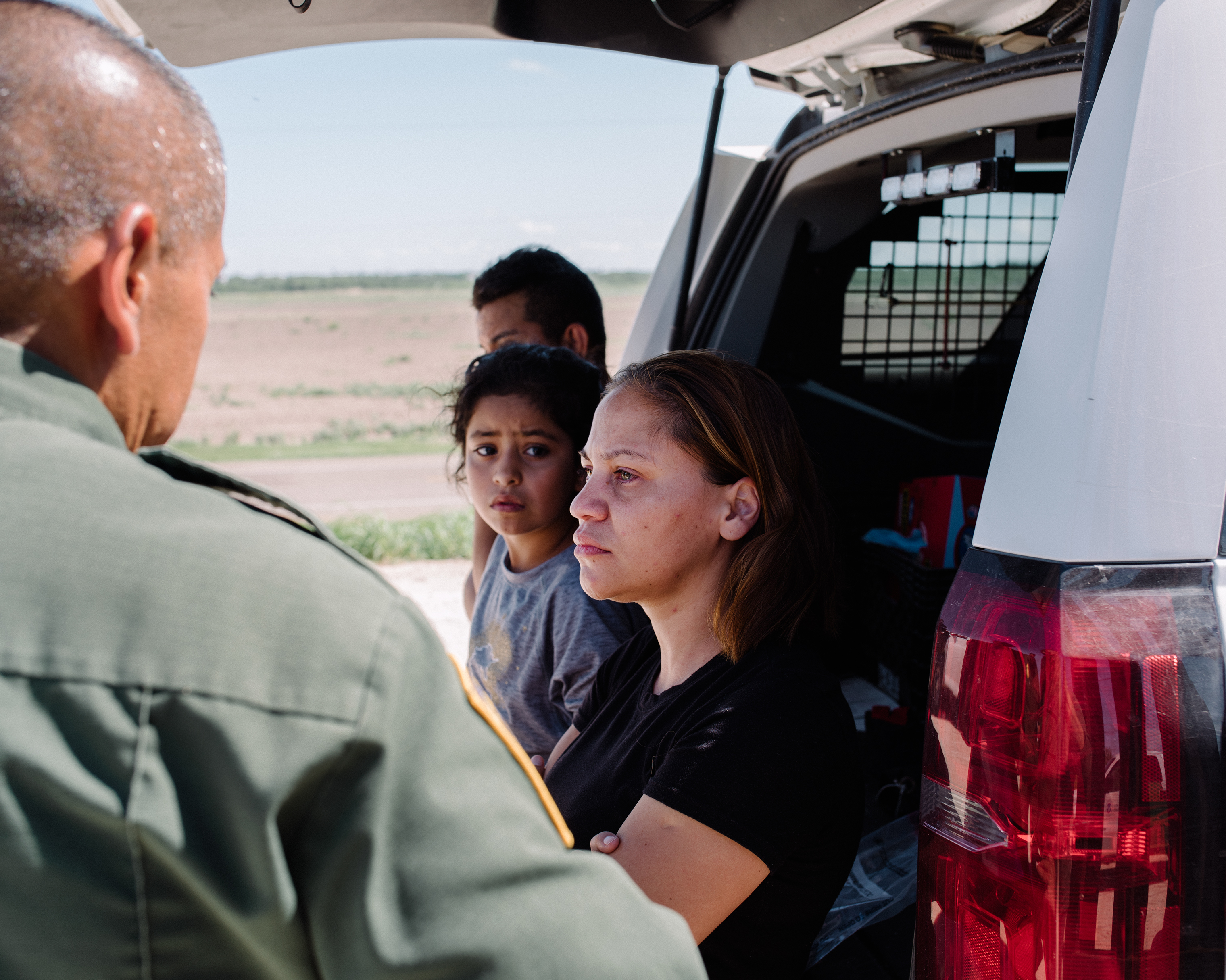
A short drive from Rivera’s post at the border, a stream of migrants, wearing GPS-tracking ankle bracelets, file into the Rio Grande Valley Humanitarian Respite Center, which is run by the nonprofit Catholic Charities in McAllen, Texas. This group of exhausted migrants is made up of family units, like the two Fredys, and all have sought asylum. Slumped into rows of blue plastic chairs and clutching bags emblazoned with the words Department of Homeland Security, they are at the beginning of a long process—one that’s become vastly more complicated over the past 80 years.
Until the 1940s, the U.S. did not have a policy governing the admission of would-be refugees: -federal laws didn’t distinguish between immigrants and asylum seekers. But after World War II left 7 million people uprooted in Europe, U.S. lawmakers were forced to act. In 1948, Congress passed the Displaced Persons Act, opening America’s immigration door to some 350,000 refugees from Europe over the next four years. In 1967, the U.S. signed the U.N. refugee protocols, voluntarily committing to protections for refugees.
Those protocols define refugees as people who are outside their country and afraid to return because of a well-founded fear of persecution based on religion, race, nationality or membership in a particular social or political group. But refugee status was for decades granted unequally through loopholes and exceptions to politically sympathetic groups, like those fleeing communist regimes in Hungary or Cuba, or escaping the crisis created by the Vietnam War. It wasn’t until the Refugee Act of 1980 that Congress created a comprehensive system for granting asylum in the U.S. If the criteria outlined in the U.N. refugee protocol were met, any applicant could be welcomed in the U.S.
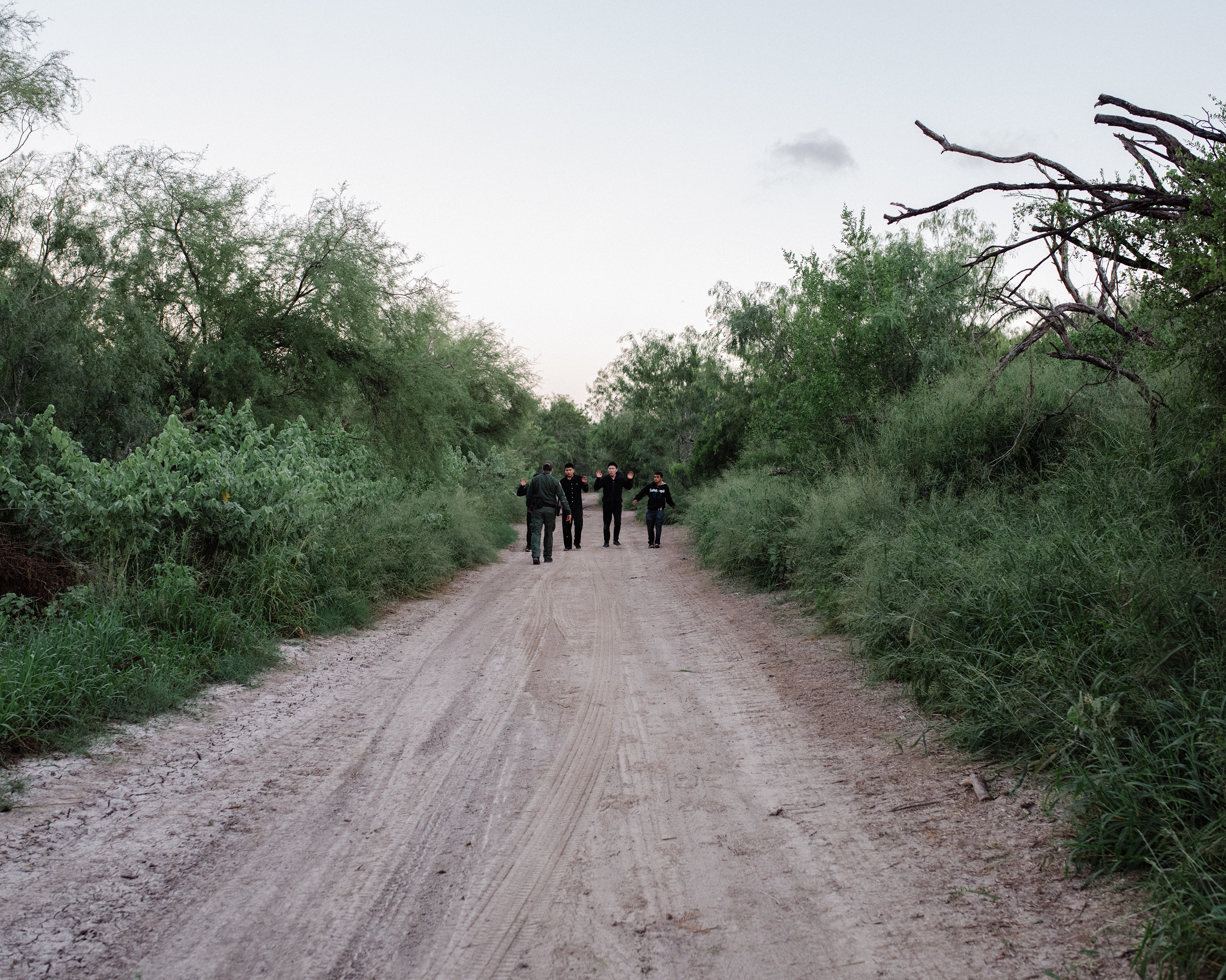
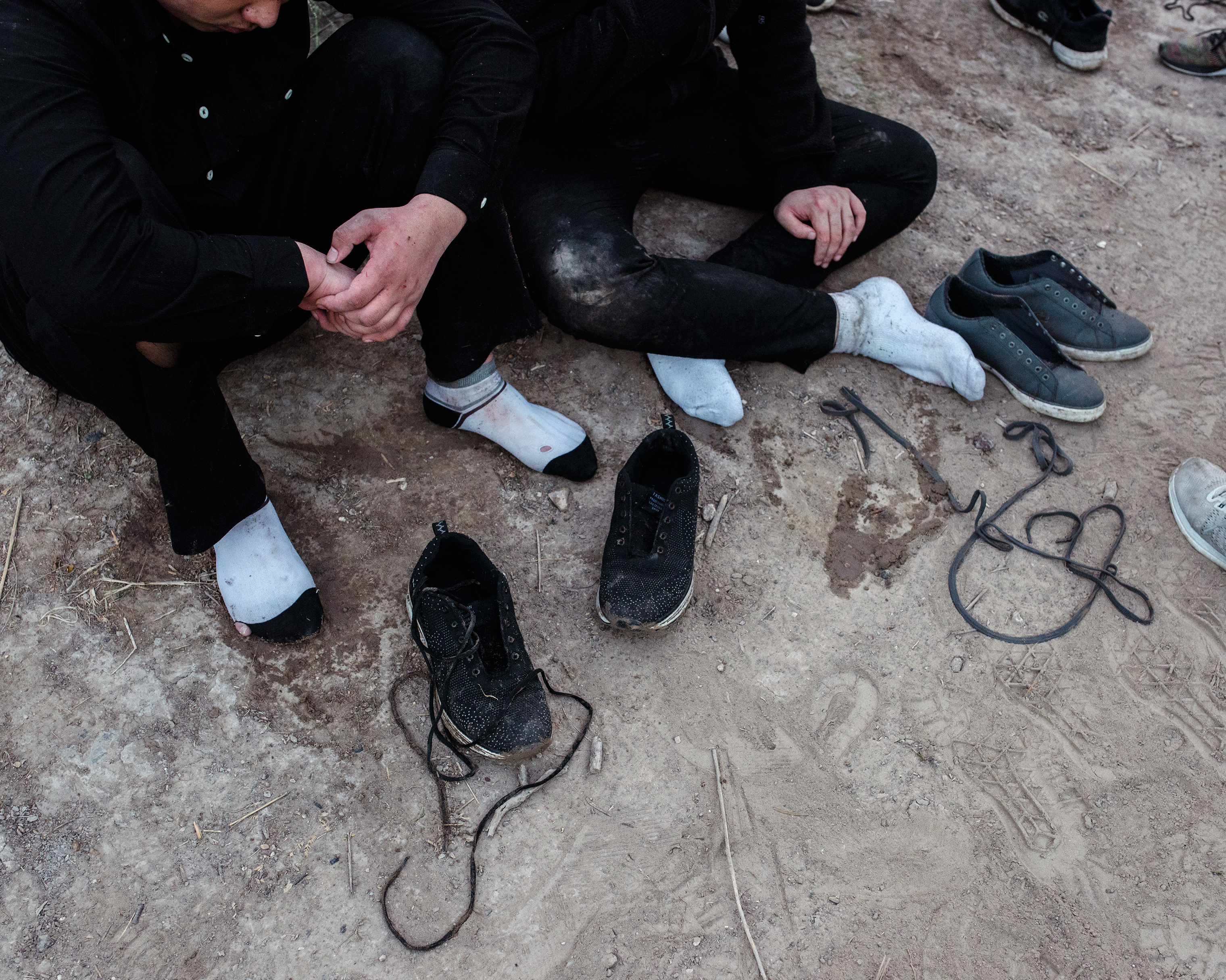
In practice, that system often kicks in when people like the Fredys come face to face with immigration authorities and express a fear of returning to their home country. A trained U.S. official then interviews them to judge whether their fears are believable. In fiscal year 2018, roughly 89% of asylum seekers passed this initial “credible fear” screening, according to federal data. But the odds narrow from there. Asylum seekers are assigned a date to plead their case in immigration court, which imposes a high burden of proof. This year, judges granted asylum in only 17% of cases decided in immigration court where migrants had passed credible-fear interviews.
What happens to asylum seekers who are not granted refugee status? That’s where the political fight really heats up. The Trump Administration says the problem is that after asylum seekers pass their credible-fear interviews, they are released from custody to await their date in immigration court—a -system Trump calls “catch and release.” With a backlog of 791,821 cases, new court dates are often months or years in the future. In fiscal year 2018, immigration judges completed just over 34,000 cases originating with a credible-fear referral, according to federal data. In nearly a third of those cases—10,534—migrants failed to show up at their scheduled court hearing.
Krikorian, the immigration hard-liner, sees evidence of bad faith at every stage of the asylum process. “Half of the people who say they have a fear and want to apply for asylum never bother after they are let go into the country,” he says. From 2008 to 2018, 53% of migrants who submitted to a credible-fear interview actually filed for asylum, according to federal data. He also claims that some who do apply for asylum expect to be denied but can benefit in the meanwhile: if more than 180 days elapse without a decision on a migrant’s immigration case, the migrant becomes eligible for a work permit. “They know they are going to be turned down,” he says, “but they get a year or two in the U.S. while they’re working.”
Padilla, the longtime Border Patrol chief, argues asylum seekers should be held in detention until their court date. The population of asylum seekers “keeps growing exponentially because they’re actually being released into the community,” he says. Sessions has made a similar case, suggesting that releasing immigrants as they pursue asylum claims creates “incentives for illegal aliens to come here and claim a fear of return.” In October, Trump told Fox News that he would build “tent cities” to house migrants until they could face a judge. “We’re going to put tents up all over the place,” he said.
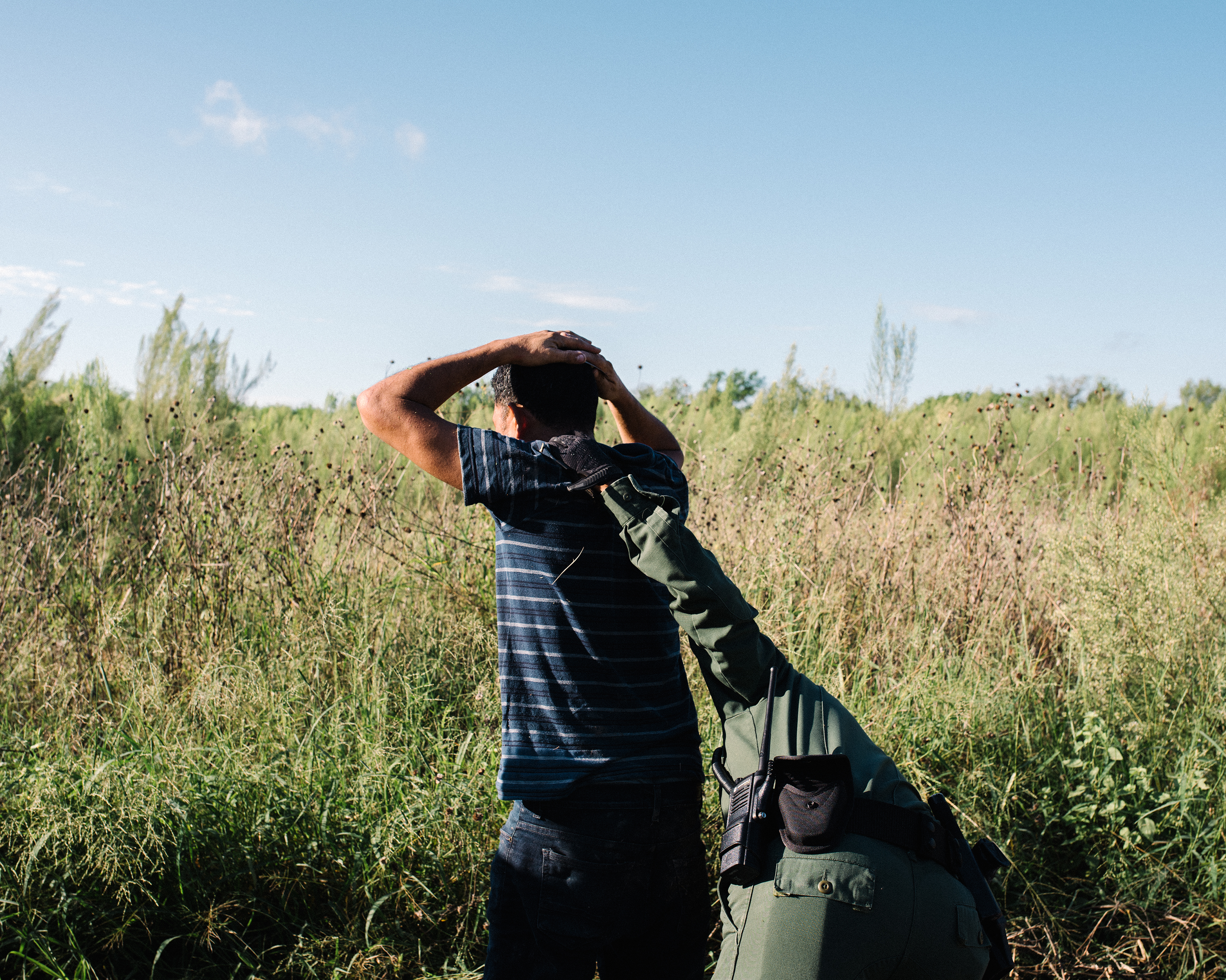
The Rio Grande Valley Sector, which stretches over 34 counties and 34,000 sq. mi. of southeast Texas, is patrolled by a small army of roughly 3,000 Border Patrol agents. Over the years, many have grown accustomed to the flow of unauthorized immigration by studying the variegated landscape, honing their tracking skills and swapping advice. After patrolling a section of the river, Rivera says, agents will sometimes pull piles of tires behind their trucks to refresh the ground so it’s easier to spot the dusty footprints. He tells a story of identifying a group of ostensible joggers as undocumented migrants by a telltale necklace that one of them wore.
Still, the job of a Border Patrol agent remains Sis-yphean. In October, agents arrested 50,975 migrants along the southwestern border—23,121 were family units, marking the highest one-month total on rec-ord. But as much as hard-liners may want to arrest all of them, immigration lawyers and advocates argue that prolonged detention of asylum seekers simply won’t work. They admit detention can deter some migrants, but only at great cost. First, the ACLU has argued in lawsuits that the prolonged detention of asylum seekers violates both a 2009 ICE directive and the U.N. Refugee Convention. Second, detaining more asylum seekers is expensive. On average, it costs $319 per person per day to detain migrant families, according to DHS. With long wait times for court dates, that will add up. Releasing migrants with ankle monitors and enrolling them in case–management programs have proved to be cheaper and more effective than detention. The Trump Administration ended one such initiative in 2017.
Perhaps the most important issue, advocates say, is that the prolonged detention of asylum seekers is immoral. Many travel as families with young children and babies. Do Americans really want to become a nation that jails hundreds of thousands of impoverished families in makeshift camps along its southern border because a portion, if released into the country, might not go through the court system to test their asylum claims?
As it turns out, both political parties bear some blame for the current mess. The crisis arguably began in 2014, under President Barack Obama, when an influx of unaccompanied minors and families crossed the southern border. The flow has increased under Trump. But instead of boosting funding to hire the many more immigration judges and administrators necessary to efficiently process asylum seekers, Trump and Obama focused disproportionately on immigration enforcement. That may have earned both Presidents political chits among rule-of-law voters, but it didn’t do much to expedite the asylum process or address the root of the problem, says Doris Meissner, director of the Immigration Policy Program at the Migration Policy Institute.
One straightforward way to stem the current influx of asylum seekers, Meissner says, would be to streamline the immigration bureaucracy. The U.S. should publicize a clear definition of who qualifies for asylum, what criteria will be considered in hearings and an explanation of what it takes to prove your case for refugee status. The Justice Department, Meissner says, should bolster immigration courts so they can judge asylum claims more quickly and fairly and eliminate the case backlog. A broken immigration–justice system leaves migrants vulnerable and “invites misuse” of the system, she says.
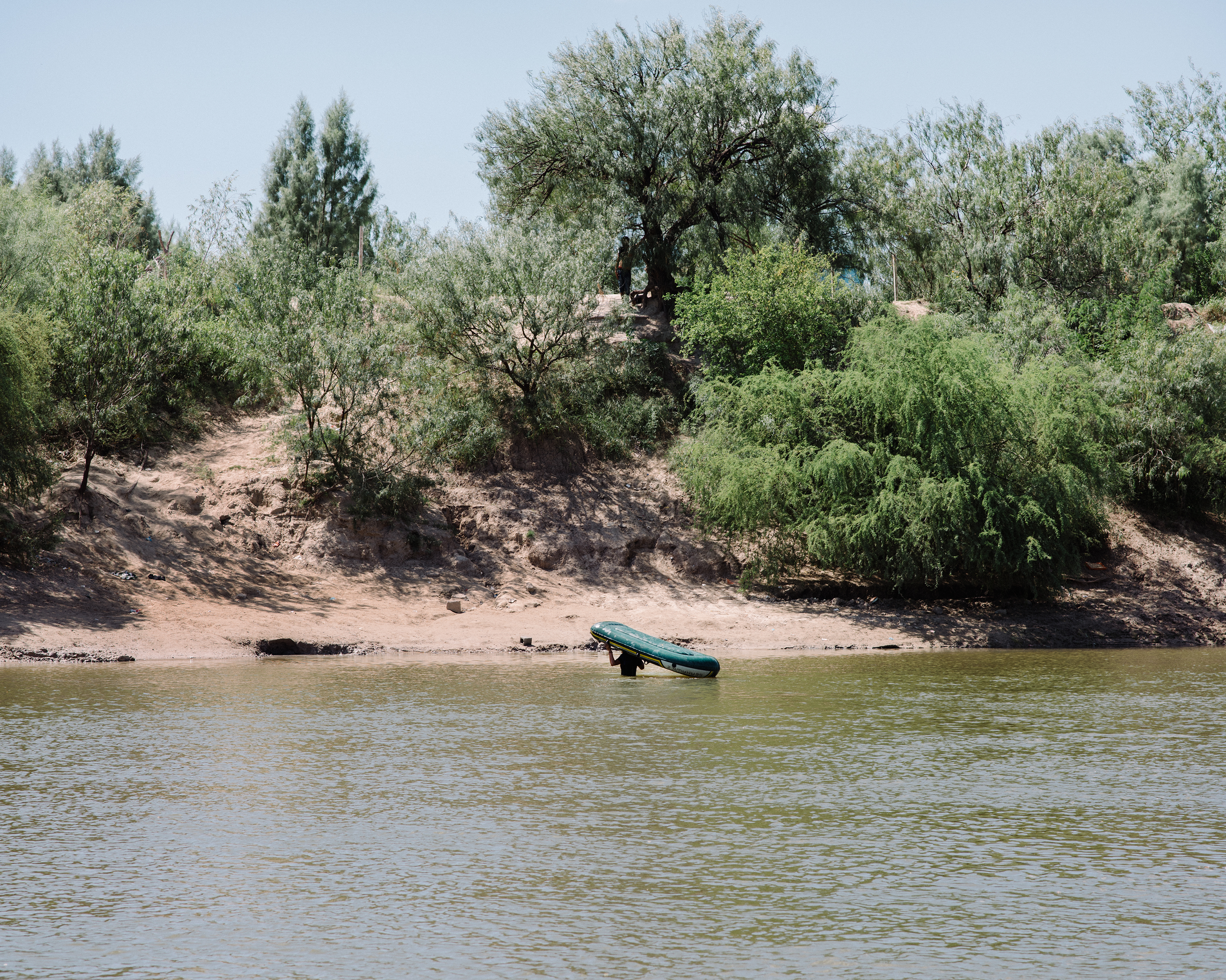
Paying for more judges and other immigration officials will be expensive, advocates admit, but less so than other politically motivated solutions, like sending thousands of active-duty U.S. troops to the southern border. To counter the migrant caravan, which is expected to arrive at the border this month, Trump has already deployed 5,600 troops, according to Defense Department officials, and he has promised up to 15,000 total. The Center for Strategic and Budgetary Assessments, an independent analysis group, -estimated that such an effort will likely cost $42 million to $110 million.
Eleanor Acer, senior director of refugee protection at Human Rights First, says any lasting solution to the migrant crisis should also address the root of the problem: poverty, violence and instability in the countries from which many of these people are fleeing. “Until the human-rights abuses and violence and deprivations and underlying issues are addressed, people will continue to flee their countries,” she says. “We actually have to deal with the problems that are causing people to leave their homes.” She recommends investing in jobs, economic development and other long-term foreign-aid programs.
Back in the Rio Grande Valley Sector, Padilla, the longtime border agent who calls for detaining asylum seekers until their court hearings, agrees that any viable solution should deal with all the sources of the problem. It’s not enough to scare people into not coming to the U.S., he says. “There have been efforts, Band-Aid efforts, to deal with this population during both Administrations,” he says, referring to the Obama and Trump presidencies. “But immigration reform has not happened to really deal with it.”
Until that solution comes, agent Rivera says, he and his colleagues will continue doing the work they do, monitoring the thickets at dawn, walking the riverbank and arresting and processing the migrants they find. At the end of a long, warm afternoon, Rivera’s radio comes alive again. An agent’s voice crackles over the line. A family of five have been caught crossing the border, he says. They have asked for asylum. Rivera speeds to the scene.
- L.A. Fires Show Reality of 1.5°C of Warming
- How Canada Fell Out of Love With Trudeau
- Trump Is Treating the Globe Like a Monopoly Board
- Bad Bunny On Heartbreak and New Album
- 10 Boundaries Therapists Want You to Set in the New Year
- The Motivational Trick That Makes You Exercise Harder
- Nicole Kidman Is a Pure Pleasure to Watch in Babygirl
- Column: Jimmy Carter’s Global Legacy Was Moral Clarity
